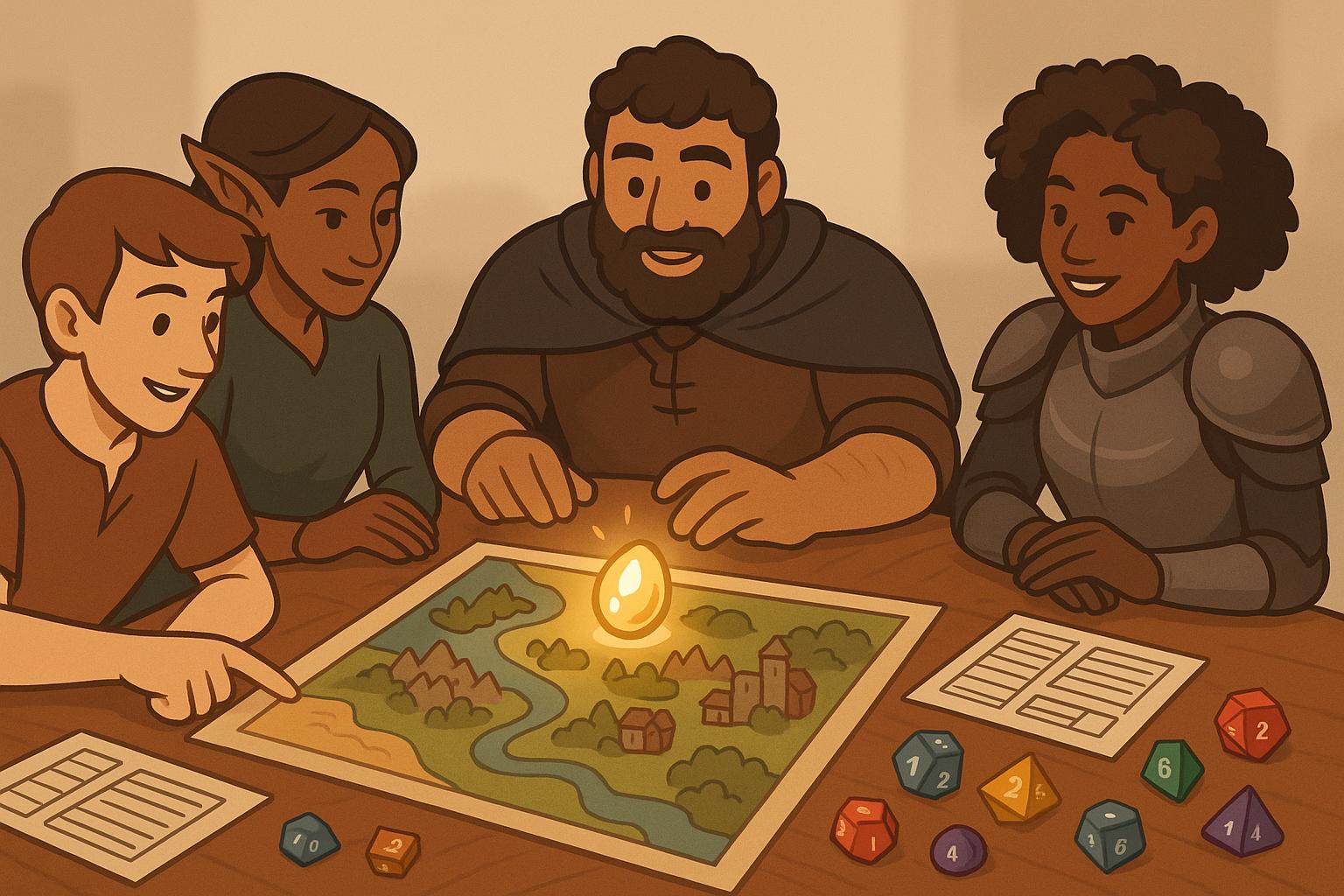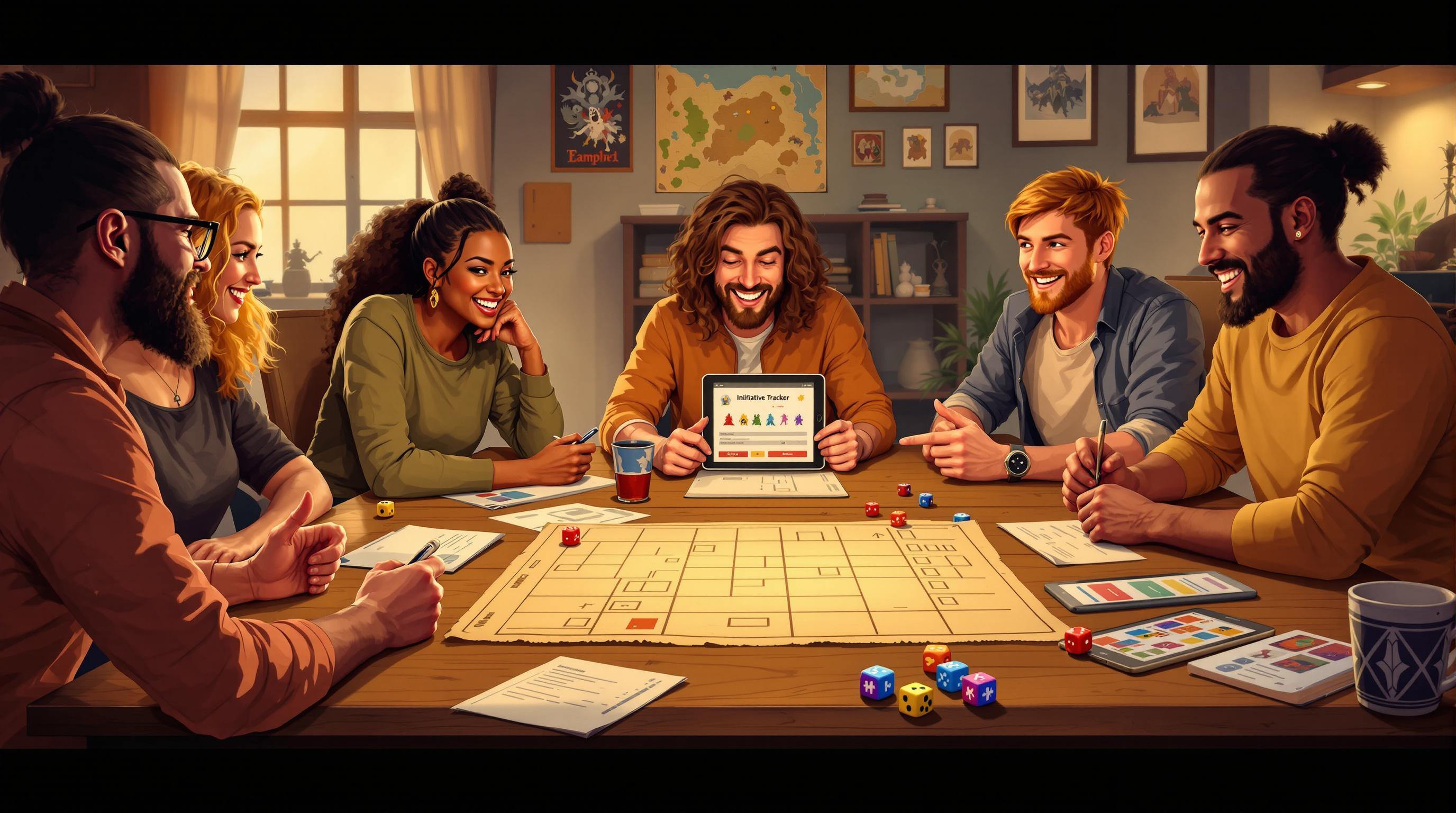Want to improve your RPG sessions? Start here. Pacing and tension are the backbone of engaging tabletop role-playing games. They control the flow of action, keep players emotionally invested, and prevent sessions from dragging or feeling overwhelming. Here's what you need to know:
- Pacing: Balance fast action (combat, chases) with slower moments (exploration, roleplay). Think of it as a rhythm that keeps the game moving.
- Tension: Build stakes and uncertainty with time limits, moral dilemmas, or unpredictable challenges. Then, provide relief to avoid burnout.
Quick Tips:
- Alternate between action, character moments, and downtime to maintain momentum.
- Use tools like progress clocks (Blades in the Dark) or resource management (Torchbearer) to naturally guide tension.
- Tailor pacing to your game’s genre: horror thrives on dread, comedy needs structured chaos, and fantasy benefits from long-term arcs.
Ready to dive deeper? Learn how session structures, mechanics, and genre-specific tactics can transform your campaigns.
Basic Elements of RPG Pacing
Session vs Campaign Pacing
Game Masters (GMs) need to balance two levels of pacing: the immediate rhythm of a single session and the broader flow of an entire campaign. Think of it like conducting an orchestra - sessions are the individual pieces, while the campaign is the full symphony [1][3].
Session-Level Pacing benefits from a clear structure to keep players engaged:
| Time Block | Activity Type |
|---|---|
| Action Phase | Combat or chase scenes |
| Character Development | Roleplay or exploration |
| Cooldown | Loot analysis or NPC interactions |
For campaigns, pacing involves weaving multiple storylines together while resolving major plot points at the right time [8]. The goal is to maintain momentum without overwhelming or losing players. Each session should feel like a satisfying chapter in a larger, cohesive story.
Building and Breaking Tension
Managing tension is like controlling the volume in music - there needs to be a balance between building excitement and offering moments of relief. For example, horror games often use a 3:1 ratio of tension to rest, while comedy games aim for a more balanced 1:1 [7].
You can gauge tension levels by watching players’ behavior:
- Leaning forward suggests high engagement.
- Quick response times (under 15 seconds) indicate good pacing.
- Frequent phone use often signals a loss of focus [2].
A tool like the Tension Ladder, which uses a 1-5 scale to measure intensity, can help track dramatic shifts. Finding the right rhythm between escalation and de-escalation is crucial. This "swell-and-lull" pattern keeps players emotionally invested without wearing them out. It’s all about knowing when to push and when to let them breathe.
Methods to Control Game Tension
Balancing Action and Rest
Building on the earlier discussion of the rise-and-fall pattern, this method helps guide emotional shifts during gameplay [1][11]. Different types of scenes play specific roles in managing the overall tension:
| Scene Type | Purpose | Example |
|---|---|---|
| Action | Increase tension | Combat encounters |
| Character | Add emotional depth | Conversations with NPCs |
| Recovery | Lower energy levels | Planning or short rests |
Introducing Surprises
While predictable pacing provides structure, shaking things up with unexpected moments keeps players engaged. For example, the Dread system uses a Jenga tower to create physical, escalating tension. Similarly, introducing layered surprises - like moral dilemmas or unexpected consequences - can amplify the stakes [1][11].
For investigative scenarios, time-sensitive elements like fading magical traces can keep players on edge. Props or mechanics that tie directly into gameplay, such as the Jenga tower in Dread, are excellent tools for maintaining pressure during exploration phases [10][12].
Using Humor Wisely
Adding humor can provide much-needed relief, but timing is everything - especially when considering the game's tone and genre.
"Pacing is all about contrasting emotional intensities...you need low-intensity moments to serve as punctuation" - Campaign Mastery RPG Blog [1]
Skillfully placed comic relief keeps the narrative flowing while offering players a breather, ensuring the overall experience remains engaging [12].
How to Master the Art of Pacing In TTRPGs
sbb-itb-b8b00a5
Game Rules and Pacing Effects
RPG systems use their core mechanics to guide the flow of gameplay and naturally build tension. These rules often act as unseen directors, influencing player choices by applying pressure through the game’s structure.
Managing Time and Resources
Games like D&D 5E rely on mechanics such as spell durations and optional resting rules to push players toward strategic decision-making [1]. For example, the gritty realism variant stretches short rests to 8 hours and long rests to 7 days, forcing players to rethink how they conserve and use resources over long campaigns [3].
In Torchbearer, tension is heightened through strict resource management:
- Light sources create a constant time limit.
- Supply slots require players to prioritize between carrying gear or treasure.
- Inventory limits compel players to make tough strategic choices.
Progress Tracking Systems
Some systems use visual tools to represent progress and build tension. These mechanics bring the "tension ladder" concept to life.
For instance, Blades in the Dark uses progress clocks - pie chart-like trackers divided into segments. As segments fill, complications increase, creating a sense of urgency and escalating stakes [5].
Meanwhile, City of Mist ensures a steady story flow by requiring GMs to introduce a new mystery and intensify an ongoing threat in every session. This structured method keeps the pace engaging while still feeling organic [2].
Games with Strong Pacing Rules
Certain games stand out for their ability to maintain momentum. Blades in the Dark avoids planning slowdowns during heists by allowing players to use flashbacks to retroactively prepare. Similarly, Powered by the Apocalypse games like Monsterhearts keep the tension high with moves that naturally lead to consequences, driving the story forward [9].
Pacing Tips by Game Genre
Different game genres call for specific pacing techniques, though they all rely on the core tension principles discussed earlier.
Horror Games: Sustaining Dread
Horror RPGs thrive on keeping players in a constant state of unease. For instance, in Call of Cthulhu, the Sanity system gradually chips away at a character’s mental stability, creating a steady sense of dread [4]. This mirrors progress clocks often used in game mechanics to build tension.
A good horror game balances time pressure (like countdowns), sensory limitations (restricted perception), and safe zones (moments of relief) [2]. In Curse of Strahd, the use of isolated settings and timed events ramps up player anxiety naturally [7].
Comedy Games: Keeping the Laughs Rolling
In comedy RPGs like Paranoia, the pacing revolves around structured chaos. Humor works best when paired with stakes that keep the narrative moving [6].
"The one-shot structure creates comedic timing through mechanical pressure" [6]
Take Honey Heist as an example. Its one-shot format sets up ridiculous scenarios, with escalating mechanical challenges that generate humor effortlessly [2].
Fantasy Games: Crafting Long Arcs
Fantasy campaigns often unfold over extended periods, requiring careful pacing to maintain engagement. The Wild Beyond the Witchlight does this well by weaving faction interactions into the story, creating natural points of progression [9][7].
For managing these sprawling campaigns, consider the following structure:
| Phase | Focus | Method |
|---|---|---|
| Early | Character Development | Tie milestones to personal quests |
| Mid | World Building | Shift between multiple plot threads |
| Late | Epic Confrontations | Use modular story arcs with rising tension |
Conclusion: Next Steps for Better Pacing
Improving RPG pacing starts with focused practice on session rhythms. Use post-session surveys with a 1-10 momentum scale to gather actionable feedback [7]. These methods build on the earlier strategies and mechanics tailored to different RPG genres.
Here’s a session structure you can try right away:
| Phase | Duration | Focus |
|---|---|---|
| Opening | 15-30 min | Scene framing |
| Mid | 60-90 min | Action/downtime (60/40) |
| Conclusion | 30-45 min | Resolution & hooks |
"The Three Pillars system combines character motivation tracking with consent check-ins, creating natural pacing breakpoints throughout the session" [2]
For more resources, the TTRPG Games Directory offers a wide selection of systems organized by pacing mechanics. A great example is Urban Shadows, which uses faction initiative systems to handle political intrigue effectively.
Watch out for these common mistakes when trying new pacing techniques:
- Overusing cliffhangers without delivering satisfying resolutions [5]
If you're running virtual tabletop games, digital tools like automated transitions can help sustain momentum [5]. These tools work well alongside mechanical pacing aids such as progress clocks and time limits.
Different genres require different pacing tactics. Horror games benefit from a slow build of tension, while comedy thrives on well-timed breaks [7]. Use the TTRPG Games Directory's filters to find systems that align with your campaign's needs.


